


Copyrights NEXYAD 2005-2006 all rights reserved
Terms of use of images and graphics copied from this page : Policy
Keywords
: Drops detection, drops detection on the windshield, wiper tester,
DropNexTM,
Frequently Asked Questions, DropNex FAQ, NEXYAD.
DropNex FAQ
- What DropNex application software does ?
DropNexTM is an artificial vision-based system that acquires images focused on the windscreen, detects and recognizes drops (drops detection), and computes among time, statistics such as : number of drops, size of drops (mean, standard deviation, ...), ratio of wet surface (water may flow on the windscreen without making drops ...), ...
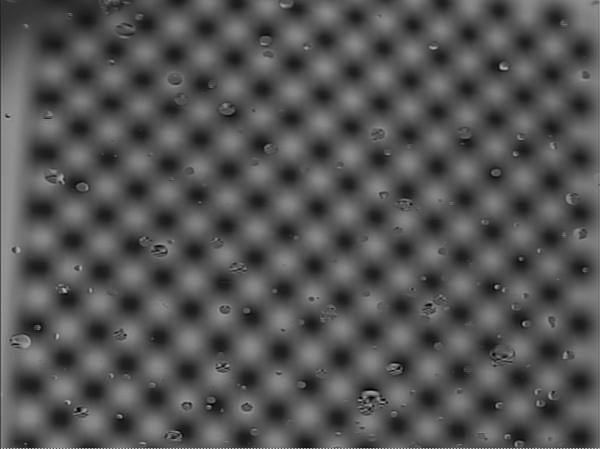
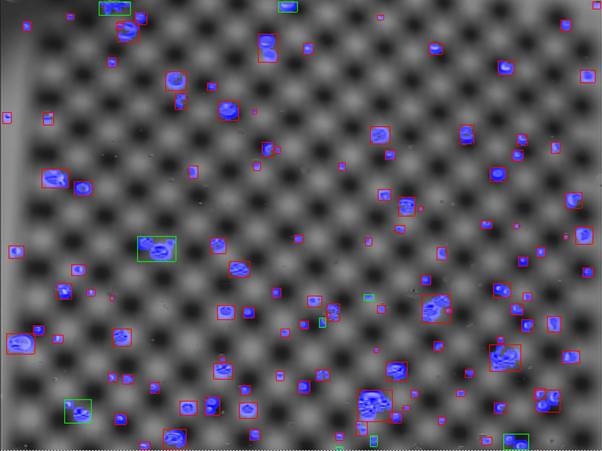
acquired image at time t detection image at time t
- What is the installation ?
A camera is inside the car (or at least beyond a windshield). A rain machine sends drops on the windshield. The camera grabs images of drops laid on the windshield. The DropNex application software detects and recognizes drops, count them, and edits statistics of drops among time (number of drops, size of drops, ...).
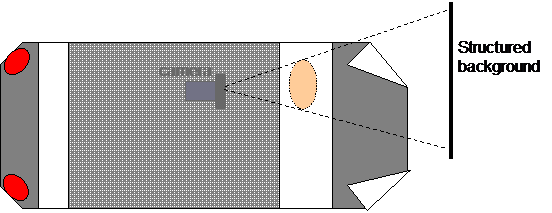
- What are the main applications of DropNex ?
. write the quantitative task book for a rain machine
. validate your rain machine at delivery
. tune presets of your rain machine in order to make it produce "interesting rains"
. make sure that artificial rains that you use in the lab are statistically similar to natural rains.
- May i use DropNex for outdoor grabbed images (during regular driving) ?
Yes.
DropNex was made to control and measure rain coming from a rain machine (ex : RainNex) in a Laboratory. But DropNex also allows to make measurements OUTSIDE ! (while regular driving)
It means that representativity of artificial rain can now be estimated in a quantitative way (if statistics of your artificial rains are similar to statistics of natural rains, you are sure that tests in the Lab are valuable). It also means that your rain machine task book can be written with quantitative goals (quantitative description of the expected rain).
- Why does DropNex have 2 methods for drops detection ?
DropNex can be applied with 2 methods of detection :
- Structured background : this option is usable in the lab only : a structured an immobile background is put behind the windshield. This background is known by DropNex that can compares every grabbed image to this background and detect every modification. This detection method is very sensitive. It is made for the lab only (because it needs a structured immobile known background). This option is useful for artificial rain presets accurate tuning phases.
- Unknown background : this option is usable both in the lab and outdoor. An advanced algorithm of sharpness detection is applied. The possibly moving and unknown background must be fuzzy (unfocused) and the focus on the windshield must be very accurate. It is possible to do so if the depth field of the optic is very short (diaphragm wide open) and if the accuracy of focusing the windshield is high enough. For that, a calibration procedure allows users to make sure that the tuning of optic parameters are fine. Then it is possible to extract drops from the unknown background. Of course, accuracy of such a detection cannot be as perfect as accuracy of the first method (first method is "perfect"). But we could show that size of detected drops and number of detected drops among time are similar. The idea is to use the "unknown background" option for measuring statistics of rain outdoor, and then to test the rain machine (write quantitative specification for the rain machine, validate the rain machine at delivery, ...).
A statistical link is estimated between the two methods (by linear regression) , and then, it is possible to extrapolate from outdoor measurements (with the second method) what is expected in the lab, under the artificial rain machine (measurements with the first method).
- How can DropNex cope with the outdoor moving background ?
Camera optic is focused on the windshield and the image is sharp only on a small depth field; so drops are sharp and background is fuzzy. An advanced sharpness/fuzzyness estimation algorithm allows DropNex to filter images and extract drops (well focused objects) from the background. No matter how it moves.
- How can DropNex cope with camera saturation outdoor ?
Areas of natural images outdoor may be saturated (example : white sky). On these images, it is not possible to detect drops. DropNex screen every image and then quotes every area : "acceptable", or "not acceptable". Not acceptable areas are not analyzed by the drop detection algorithm. Statistics of drops (example : number of drops per cm2) are computed on the acceptable surface only (that usually changes from an image to another).
- What is the precision score of DropNex ?
DropNex is a vision-based tool. It means that precision cannot be better than 1 pixel.
Theoretical considerations allow us to say that the smallest detectable object (that can be seperated from noise) is 2 x 2 pixels.
An error of 1 pixel for a 4 pixels shape represents 25% (huge error !) on the estimation of size parameters.
We consider 10 pixels as being the regular size for small drops. The user must configurate the acquisition system (optic, camera, computer) in order to get this result.
- What is the reproductivity score of DropNex ?
Reproductivity of DropNex measurement is very good : every element of the advance drops detection algorithms is deterministic : same images always lead to the same result.
Similar drops are detected the same way (error = 1 pixel).
- Does DropNex detect ALL the drops ?
No it doesn't : for the smallest drops (4 to 5 pixels), detection rate is from 90% to 98% (depending on the lightning and the good or bad calibration of the acquisition system). But in practice (see next FAQ), the smallest drops of interest must have 10 pixels. In such a case, detection rate is 100% (for a good calibration).
- What is the smallest size of drops that can be detected with DropNex ?
In a theoretical point of view, the smallest size of detectable object that can be seperated from noise is 2 x 2 pixels.
In practice, we could show that most 5 pixels drops can be detected, but estimation of their size is generally not very good (error of 1 pixel = 20% for a 4 pixels drops !).
We consider 10 pixels as being the regular minimum size of detected drops that leads to a good precision of surface, radius, ...
Knowing this size in pixels, and knowing the minimum size in mm (radius of drops) that you wish to detect for your application, it is possible to size the application :
N x M = number of pixels of your camera
Teta = angle of the optic (degrees of angle)
L x W = size of the seen part of the windshield (in mm x mm)
D = distance camera windshiel (in mm)
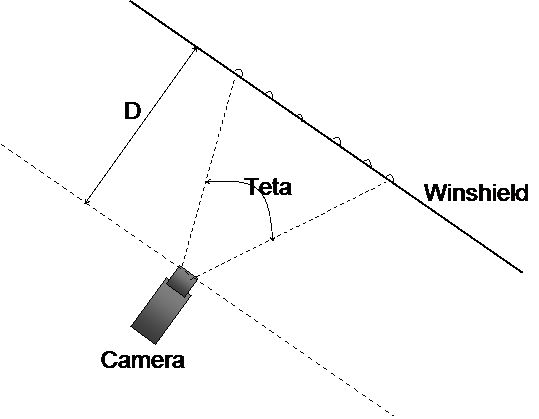

example : N = 1400 pixels (HDV regular spatial resolution)
L = 14 cm
then, 1 mm <-------> 10 pixels
=> drops with a radius of 0.5 mm are detected and accuracy of size estimation is good (error < 10%)
NB : drops between 5 and 10 pixels (here, a radius from 0.25 mm to 0.5 mm) are still detected (score of detection > 95%), but the estimation of size has a poor relative precision.
NB : with a professional camera (example : 3000 x 3000 pixels), and a seenable range of 10 cm on the windshield, then 10 pixels <----------> 0.3 mm (radius of drops 0.15 mm).
So, as a conclusion, there is no limit of drops size : whatever the expected minimum size of detected drops is, it is possible to configurate your image capture system that will lead to 10 pixels for this minimum size ... NEXYAD can help you dimensionning your image acquisition system if you give your industrial constraint (min size of detected drops, accuracy of size estimation for the smallest detected drops, ...).
- Is it possible to use several cameras in order to see a wide range of the winshield ?
Yes it is. DropNex computes detection algorithms from grabbed images. The only point to do is to calibrate every camera. Our regular application software doesn't provide functionnalities of agregation of the results obtained with several cameras : the standard version will generate 1 result file by camera, and it would be your job to put them together. NEXYAD is always open to the development of needed options. Working with several cameras is possible (just make sure that your hardware can cope with the complete data flow) on request.
- Is DropNex able to give directly the size of drops in mm and mm2, instead of "number of pixels" that have no meaning for me ?
How does DropNex cope with the curve of the windshield for its real size estimation ?
Of course, DropNex is able to give directly the size of detected drops in mm (for the radius) and in mm2 (for the surface) : a geometrical callibration is operated befor the measurement :
A specific target must be put on the windshield :
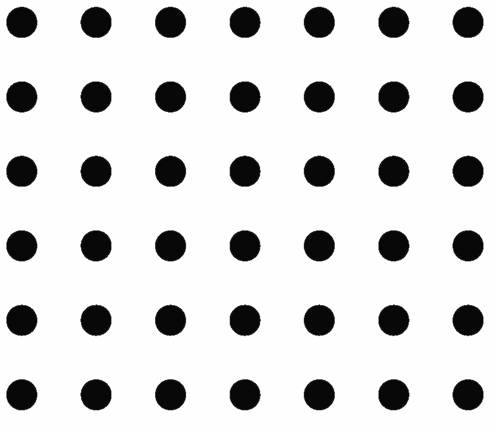
Curve of the windshield leads to image deformation :
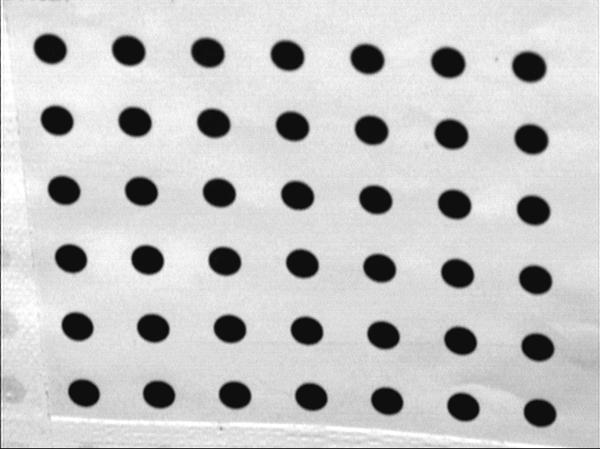
The distance between black spot (and their size) is known. Then the tranduction pixels <------> mm can be done for every area of the acquired image.
After this geometrical calibration phase, DropNex is able to produce every result with physical units (mm for length, mm2 for surfaces).
- What is a "good calibration" of the image acquisition system ?
There are two parts in the calibration process :
1 - the geographical calibration (see previous FAQ)
2 - the optics calibration :
- focus must be very accurate ON the windscreen
- diaphragm opening must be enough in order to get a short depth field : drops must be sharp, and background must be fuzzy
- lights must not lead to saturation
- backgroung image (in the lab) must be appropriate (we provide background images).
NEXYAD provides tools that help the user to know is the calibration is good or not (scores of good calibration).
- Is DropNex a real time application ?
No. Acquisition of images can be made with any camera in real time (industrial camera, digital camescope, ...). Image sequences are then put on the hard disk of the computer (.avi image sequences, or directory of .bmp images). DropNex reads these recorded images and computes the statistics of rain for every image.
If there is a need for real time DropNex, this should be developed. NEXYAD is always listening to the voice of customers.
- Does DropNex solve ALL my industrial problems ?
Of course not, DropNex is a tool.
Once people understand how powerful the DropNex detection of drops is, they usually extrapolate to other tasks : mosquitos, dust, ... and they ask is DropNex is able to detect and recognize all these items.
The answer is no.
This tool was made for a given task (drops detection on the windshield). As any real world object, this tool is not as perfect as the "idea of detection"' ... But this tool works in the real world. It has a finite precision, a known repeatability, ... A set of very smart calibration procedures (fully described into the user manual) leads to very good detection results (and accuracy of DropNex is much better than ... "by hand" estimations).
Using this tool allows you to gain time and then it lets your firm save money (shorter time to business cycle, ...). You keep your know-how, your creativity.
As any other advanced tool (such as computers, for instance), DropNex will just be an amplifier of your work.
- What are the main argumentation that should lead me to become a DropNex user ?
- "I wish to buy a rain machine" :
- write the technical specifications of the expected rain machine (you measure natural rains ootdoor, and you wish to generate artificial rains that a statistically similar ...) : your task book is completely clear.
- validate a rain machine : once your supplier delivers the rain machine, you can test it in order to make sure that the desired rains can be generated.
- tune a rain machine : during tests, you may want to generate a new kind of rain (that you found as being an interesting kind of natural rain). So you can use DropNex in order to measure the statistics of your artificial rain (you tune the technical parameters as long as you don't have the expected rain statistics).
- "i want to make sure that tests are repeatable" : measurement of a rain statististics becomes invariant with time, engineer, ...
- "i need to exchange 'rain description' with my colleagues or with my partners (customers, suppliers, ...) " : rain statistics are quantitative measurable data.
- "i don't want to lose my time developing a tool that i won't sell anyhow, because my firm is not a software company (i work for a rain sensors supplier firm, i work for a car manufacturer, ...)"
: NEXYAD has solved many detection and pattern recognition applications. Time to obtain the same accuracy than DropNex should be "long" and NEXYAD always works on
this tool that evolves and lives through releases (with maintenance, hotline, tutorials, ...). For a big firm, it is just a matter of budget : if a big firm really wants to develop an application that
would have exactly the same accuracy than DropNex, it is only a matter of resources matching. We just think that the cost for development AND maintenance should be much higher than
buying an available system (+ if you develop your own tool ... the suppliers and the customers ... don't have the same tool : communication is not easy).
- "i wish to use a 'standard' tool that already has industrial users" : no one thinks about developing their own PC ... If you're an expert of automotive on-board systems, it is more effective to
focus on YOUR know-how, and to buy existing tools for measurements, testers, ... Buying effective existing solutions is cheaper, quicker, easier, ...
- "i would like to use this tool, but i also developed a special know-how in rain measurement that i wish to keep" : no problem, DropNex works on our open software and hardware architecture
that can easily integrate your existing tools. You can also integrate DropNex into YOUR software and hardware architecture.
- May i test DropNex (during 2 or 3 months, for instance) without buying the whole modular hardware and software architecture ?
Yes.
A cheap "for rent" application software is available. You record your image sequences (with any of your camera), and the software will analyze your images and detect drops.
All options of DropNex drops detection advanced algorithms are available on this for rent time limited evaluation version.
- May i buy only the application software DropNex and plug it into my own architecture ?
Yes.
DropNex application software reads input files, runs detection and drops classification algorithms, and writes result files. Our open architecture pilots DropNex from the outside, so YOU can do it too : NEXYAD provides every needed information (format of files, entry points to "call" DropNex from another program, ...). You can build your own software and hardware architecture around our applications software such as DropNex.
- Do i need a precise positionning of the camera ?
No you don't. The geographic calibration copes with the positionning of the camera. Of course, the more the camera is perpendicular to the windshield, the most the number of pixels for every "black point" of the calibration image will be the same => precision of size estimation (in mm) will then be the same for every area of the seen part of the windshield.
- Other questions ?
Please feel free to contact us : gyahiaoui@nexyad.com +33 (0)139 04 13 60